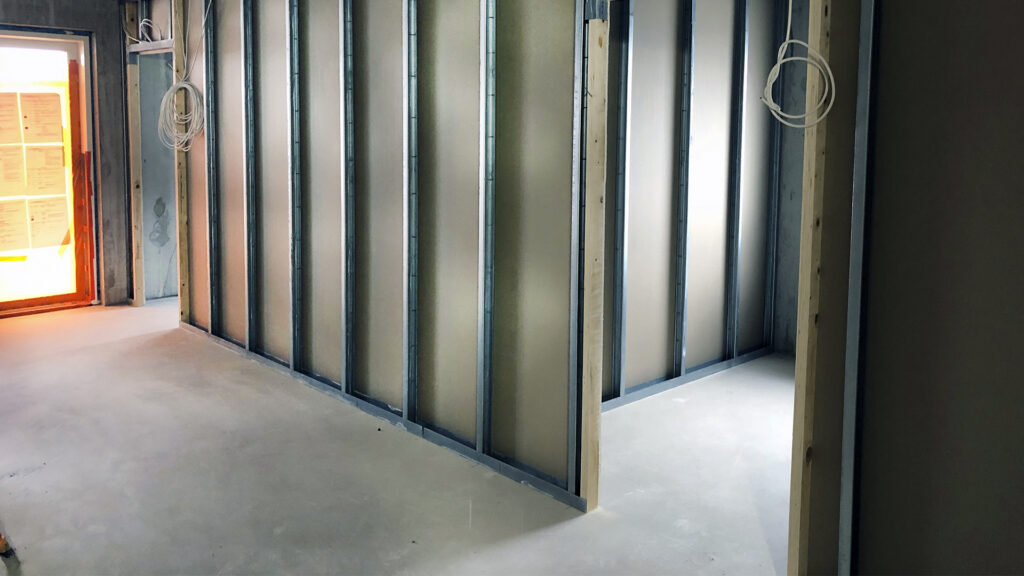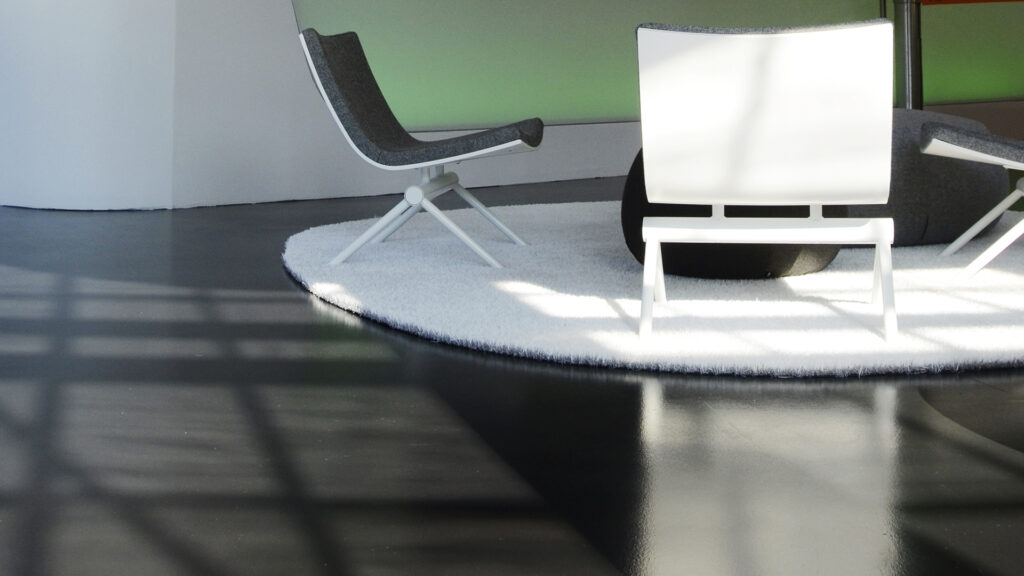Installing plastic carpets and other dense coverings is challenging in terms of healthy indoor air. A long-lasting study confirmed that the keys to the solution have been known for a long time.
A research project called Damage to plastic covered floors due to moisture was carried out at the University of Tampere in the years 2017–2023. In a joint project of several financiers, the behavior of plastic covered floors was monitored for five years after the coverings were installed.
The key result was that a low-alkaline screed should always be added between the plastic mat and the concrete, which can be used to prevent indoor air problems caused by the chemical decomposition of plastic mats and adhesives.

The largest research project
Let's recap what it's all about. The high pH value of concrete and humidity can together cause hydrolytic decomposition, i.e. damage to the plastic mat and the glue used with it. It can also cause indoor air problems over a long period of time.
According to research, alkaline moisture can be combated with a low-alkaline leveling layer. If the humidity of the concrete increases, the protective effect of the screed decreases. That's why you should also take care of the site conditions and that the humidity of the concrete stays within the limit values, i.e. 85 percent of the current recommendation.
The research was exceptionally long-lasting, but its results were put into use exceptionally quickly. That's what the researcher says Virpi Leivo from the University of Tampere. A similar long-term follow-up study had not been conducted in Finland before, and apparently not on such a large scale in the Nordic countries either.

Recommended for use immediately after the first results
The results were put into practice already after the first phase of the study. In 2019, a building recommendation was published on the use of a low-alkaline screed with a thickness of 5 mm. Construction industry RT expert Jani Kemppainen according to the recommendation was not binding, but it was implemented quickly and comprehensively.
Industry players give cautious comments about how the results and new practices have affected indoor air problems in the big picture.
"Enlightenment has reached its destination. There is less coverage of problem areas than before these investigations of the last few years", CEO Jari Lahtinen The floor and wall covering joint says.
Overall, the understanding of the interplay of concrete, screeds and plastic carpet seems to have grown.
"The researched information is useful when someone asks: is it absolutely necessary to put a screed, if I just put a coating directly on this concrete. The project also underlined the importance of low alkalinity. It's good to rely on concrete results," says Kährs' product manager Tomi Tehomaa.

The acidity of the substrate is decisive
Those more familiar with the field state that there was nothing completely new in the research itself. In Sweden, the effect of the low-alkaline screed was already noticed in the 90s. In Finland, the result was at least partially known. However, the practice and traditions leaned a little in the other direction.
"It was known from Sweden's experiences that a low-alkaline leveling layer helps. But even though it has been known since the 90s, in Finland the idea that the screed is an additional item of expense is strongly held. Even in the regulations, the focus was mainly on the fact that the concrete must be dry enough", Master of Civil Engineering Jommi Suonketo says.
Suonketo has worked as a researcher at the University of Tampere and has worked on indoor air problems in his own company for nearly 30 years.
"Finland had and still has a well-organized and functional approach based on moisture measurement, which has been used to manage the construction process. But it is not the only correct point of view with glued tight coverings. Many times it doesn't even matter that much, because the pH of the substrate is what decides," Suonketo estimates.
Simply internalizing the need for screed is not enough, but you must also know how to use it correctly in contracting.
"In terms of the indoor air problem, it doesn't matter if there is screed on, say, 90 percent of the floor area, if that 10 percent doesn't have it. The screed must also have a minimum thickness; not the average per square, but according to the instructions in each point. I believe that nowadays it is better understood that it must be everywhere."
Research around concrete
Just under the publication of this story, a publication was completed by76 Moisture management and coating of concrete floor structures 2024. As its name suggests, it focuses on moisture management of concrete floors and also on floor coatings. The guide is an expanded version of the textbook published by Betonikeskus in 2007.
The guidelines published by the government's Terveet tilat 2028 program addressed the same topic Concrete floors covered with plastic carpet. In addition, a research project on low-carbon functional concrete floors is currently underway. In all of these, the factors are the industry's long-term conkers Sami Niemi ja Tarja Merikallio.
The focus is on managing conditions and schedules and ensuring adequate drying of the concrete already in the construction phase. Measuring concrete moisture in an already built environment has been found to be difficult, uncertain and expensive.
Research work is still being done, and Tampere's plastic carpet research didn't end here either. The floor samples, 23 in total, are resting on a storage shelf in the basement of the University of Tampere and are waiting for further processing. The test pieces have an entire floor structure: concrete, screed, glue and carpet.
"At the latest, after about five years, we will agree with the financiers on further research. And if at some point there is a need to dispose of the test pieces, we will agree on a possible sampling before then," says researcher Virpi Leivo.
Of course, all research requires funding. That's what many people hope to find from the operators of the construction industry, so that these plastic samples could be examined at least once more. The time could be, for example, when the plastic carpet samples have been languishing in their boxes for 10 years.

Plastic or not?
Although plastic mats were investigated with the help of construction blocks, these in themselves are not the core of the problem. The results confirmed that the real risk can be found under the carpet. And yet the plastic carpet has been the material from the floor whose use has been reduced, say several people interviewed for the story.
The Floor and Wall Covering Association began to inform on behalf of its member companies and made its own guidelines for plastic carpet. Five years ago, an A4-sized guide was published This is how you coat correctly.
"We have had the idea that when the conditions are right, the plastic mat is a completely safe covering to use. Indoor air problems have only occurred when the conditions are not right. When the recommendation for a sufficiently thick screed layer became public, it provided additional security for this view," notes Jari Lahtinen.
A solution may be sought in epoxy, linoleum or other coatings, but according to Lahtinen, they also have their own risks. The sales manager says the same Janne Lauronen from Tarkett Oy.
"Epoxy and polyurethane floors have not proven to be blissful solutions. The installation requires protective equipment due to unhealthy compounds and chemicals, the installation result is variable, the adhesion of the bases and materials brings its own challenges, and maintenance is more challenging and expensive than plastic mats", Lauronen lists.
"Furthermore, if you want to reduce the carbon footprint of construction, with such coatings, the CO2 emissions of manufacturing and installation are multiple times compared to even the weakest functioning plastic mat.
Epoxy coatings mixed and installed on site cannot be recycled either," Lauronen points out.
Did the research miss something? Tomi Tehomaa points out that the safe minimum thickness of the screed layer was not actually verified in the tests. It is technically difficult to make a layer that is too thin, but even a mere 5 millimeters can be challenging to implement if you go to check with a measuring stick afterwards. Researcher Virpi Leivo has a proposal for the continuation.
"In the test pieces of the Tampere study, a 5 millimeter thick leveling layer was used, and that is why it also ended up as a recommendation in the guidelines. In the future, we could optimize how thick a layer is sufficient," says Leivo.
Text: Ilona Savitie
Useful links: